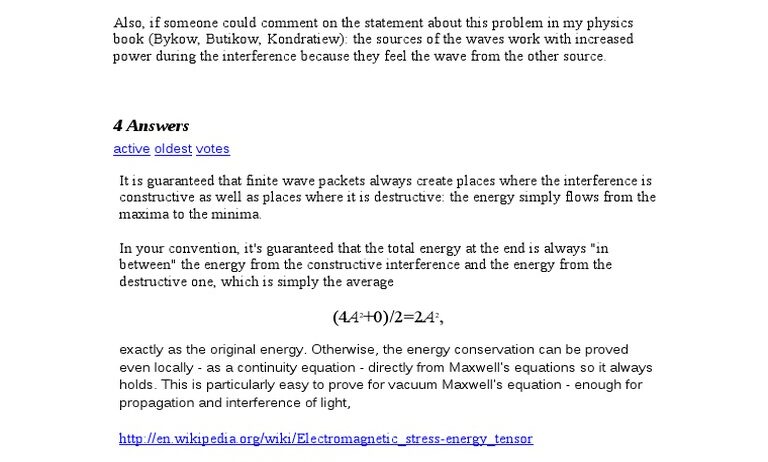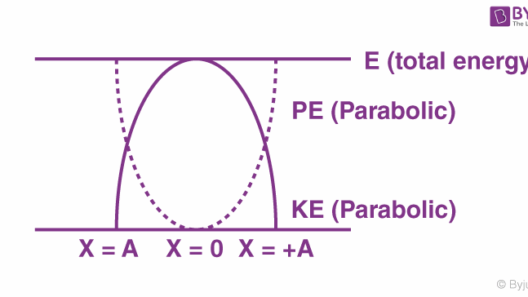The natural world exists in a delicate balance, much like a symphony, where each instrument plays its part. In the realm of physics, we often encounter intricate phenomena such as wave interference, which may seem at odds with the principle of energy conservation. Are these two concepts irreconcilable? Or do they coexist in harmony, grounded in the immutable laws of nature?
At its core, energy conservation is a fundamental law of physics, asserting that energy cannot be created or destroyed, only transformed from one form to another. This principle is akin to a wise old tree that has stood for centuries, its leaves falling to nourish the ground while new life burgeons in spring. On the other hand, wave interference—a phenomenon that can either amplify or diminish waves—invites us to delve deeper into the dynamics of energy transfer and distribution.
When we discuss wave interference, we refer primarily to the interaction between waves that can lead to constructive or destructive interference. In constructive interference, waves align, enhancing their amplitude and increasing energy density, much like symphonic harmonies that blend to create a powerful crescendo. Conversely, destructive interference occurs when waves are out of phase, effectively cancelling each other out, similar to a dissonant chord that leaves audiences yearning for resolution.
These two scenarios may give the impression that energy is being lost during destructive interference. However, it is vital to understand that energy is not being vanquished; rather, it is redistributed. The waves that cease to propagate do not disappear but reconfigure their energy, transferring it to the medium through which they travel, much like a river altering its course yet maintaining its flow.
The intriguing question arises: does this redistribution align with the conservation of energy principle? The answer lies in the nuances of interference patterns and the broader context of energy systems. In practice, when two waves converge, the amplitude of their resultant wave can be greater or lesser, but the overall energy of the system remains constant. In this sense, wave interference serves as a remarkable demonstration of energy conservation in action.
Consider the metaphor of a bustling marketplace—a hub of activity where traders interact, their goods merging and diverging. Some stalls thrive, while others may wane, but the total volume of trade remains intact. Similarly, wave interactions showcase energy’s fluidity, where it can oscillate between forms without violating fundamental laws.
One might ponder whether this phenomenon can pose challenges in real-world applications, particularly in fields such as telecommunications and acoustics. In telecommunications, for instance, the quality of signal transmission can be significantly affected by the interference of waves, leading to distortions that compromise communication. Yet, by leveraging advanced technologies—like signal processing algorithms—engineers can efficiently manage and mitigate the effects of interference, illustrating humanity’s ongoing quest to harmonize our technological symphony.
Moreover, in the realm of acoustics, sound waves behave similarly, illustrating the dance of interference in a tangible context. Think of an orchestral performance; the convergence of different instruments produces a grand sound, yet moments of quiet offer contrast and depth. In an acoustic environment, an understanding of wave interference allows sound engineers to enhance audio quality, ensuring that the symphony of sounds resonates beautifully.
Perhaps the most profound takeaway from the study of wave interference and energy conservation lies in the broader implications for environmental sustainability. As humanity faces unprecedented energy challenges, we must draw upon principles of physics to explore innovative solutions. The interplay of energies, much like waves, can inspire new approaches to conservation—seeking to amplify the efficacy of renewable energy sources while mitigating inefficiencies inherent in current practices.
This notion recalls the ongoing transition towards sustainable energy solutions. Solar panels, wind turbines, and hydroelectric systems all operate within a framework of energy transformation. Here, the principles of interference can inform the optimization of these systems. Just as waves constructively and destructively interfere, so too can energy be harvested efficiently through clever engineering, maximizing output while minimizing losses.
In conclusion, the interplay between wave interference and energy conservation reveals a landscape rich with metaphorical potential and practical implications. As with the orchestra of life, we must recognize that harmony arises from the balance of strengths and weaknesses, from the melding of diverse forces. Energy conservation, thus, is not violated by wave interference; rather, it encapsulates the elegance of energy dynamics, illustrating how even in apparent discord, a greater order prevails.
As the world confronts growing environmental concerns, embracing the principles of wave interference can enhance our understanding of energy systems. Our challenges echo the phenomenon of interference—where every action reverberates through a continuum, shaping the energy landscape of our planet. By fostering innovation informed by these scientific principles, we can cultivate a more sustainable future, ensuring that the symphony of life continues to play on, thrilling generations to come.








